Microsoft Silverlight is a powerful tool for creating and delivering rich Internet applications and media experiences on the web. Silverlight 5 builds on the foundation of Silverlight 4 for building business applications and premium media experiences. Among other capabilities, the Silverlight 5 release candidate highlights dramatic video quality and performance improvements, and features that improve developer productivity.
The final Silverlight 5 release will be available in 2011. The following article is referenced from http://www.microsoft.com/silverlight/future/
Improved media support and rich UI capabilities
- Hardware Decode and presentation of H.264 improve performance for lower-power devices to render high-definition video using GPU support.
- TrickPlay allows video to be played at different speeds and supports fast-forward and rewind. At up to twice the speed, audio pitch correction allows users to watch videos while preserving a normal audio pitch.
- Improved power awareness prevents the screen saver from being shown while watching video and allows the computer to sleep when video is not active.
- Remote-control support allows users to control media playback.
- Digital rights management advancements allow seamless switching between DRM media sources.
Building next-generation business applications
Silverlight 5 text (bottom) has improved clarity.
Fluid user interface enables smoother animation within the UI. Inter-Layout Transitions allow developers to specify animations to apply when elements are added, removed or re-ordered within a layout. This provides smoother user experiences when, for example, items are inserted into a list.
Text improvements make it possible to build rich magazine-style text layouts:
- Multicolumn text and linked text container allow text to flow around other elements.
- Tracking/leading set precisely how far apart each character is for full creative control.
- Text clarity is improved with Pixel Snapping.
- Text layout performance is significantly improved.
- OpenType support has been enhanced.
Printing:
- Support for Postscript vector printing enables users to create faster, higher-quality reports and documents, including the ability to create a virtual print view different from what is shown on the screen.
Controls:
- Added support for double-click and Combobox type ahead.
Model View ViewModel (MVVM) and Databinding enhancements allow more work to be done more easily via XAML:
- Debugging support now allows breakpoints to be set on a binding, so you can step through binding failures.
- Implicit DataTemplates allow templates to be created across an application to support a particular type by default.
- Ancestor RelativeSource allows, for example, a DataTemplate to bind to a property on the control that contains it.
- Binding in style setters allows bindings to be used within styles to reference other properties.
- The DataContextChanged event is being introduced. Markup extensions allow code to be run at XAML parse time for both properties and event handlers, enabling cutting-edge MVVM support.
- UpdateSourceTrigger allows immediate response to data entry, leveraging ViewModel functionality through databinding.
- Multiple Window support, enabling user to multi-task various functions within a common application.
- CustomTypeProvider, enabling post deployment configuration of product catalogs and other object definitions.
- CustomMarkupExtensions enabling better tooling and code optimization by extending XAML definitions to custom code.
Silverlight 5 performance improvements
- Reduced network latency by using a background thread for networking.
- XAML parser improvements that speed up startup and runtime performance.
- Support for 64-bit operating systems.
- Reduced network latency by using a background thread for networking.
Graphics improvements
- Graphics Processing Unit (GPU) accelerated 3-D application programming interface (API) provides rich graphics on the Web for building advanced data visualizations and rich user experience (UI).
- Immediate mode graphics API allows direct rendering to the GPU.
- Hardware acceleration is enabled in windowless mode with Internet Explorer 9.
Silverlight 5 extends features of the "Trusted Application" model
Silverlight 5 extends features of the ‘Trusted Application’ model to the browser for the first time. These features, when enabled via a group policy registry key and an application certificate, mean users won’t need to leave the browser to perform complex tasks:
- Host HTML content as a web browser control within the Silverlight application. HTML pages, such as help content or e-mail, can be integrated within the application.
- Read and write files to the user’s My Documents folder, making it easier to find media files or create local copies of reports.
- Launch Microsoft Office and other desktop programs. Users can open Microsoft Outlook and create an e-mail message, or send a report to Microsoft Word utilizing the power of Microsoft Office.
- Access devices and other system capabilities by calling into application COM components. Users can access a USB security card reader or a bar-code scanner.
- Enjoy full keyboard support in full screen, which enables richer kiosk and media viewing applications. - - Call existing unmanaged code directly from within Silverlight with PInvoke.
Tools improvements
- Microsoft Visual Studio profiling support including CPU, memory, and thread contention
What is an IP address?
An IP address is a set of 4 numbers assigned to each device on a computer network. When we apply this definition for the internet, the IP address can be considered a numerical representation of a website address. For example, the domain google.com would go to the IP address 73.14.213.99.
How do IP addresses work?
When you type in a domain name on your browser, your browser will first match that domain name to an IP address. Then, it will access the server at that IP address.
Why would you want a unique IP address for your website?
Websites that have unique IP addresses are more stable and more reliable.
Disadvantages of sharing an IP address:
Sharing an IP address = Higher chance of website outage
Most web hosting providers nowadays cram thousands of websites onto one server. And because IP addresses are in short supply, they will often have all of the websites that are on a server share one IP address. This practice is quite dangerous as it will jeopardize the stability and functionality of each website on the server.
If your website is sharing an IP address with 1,000 other websites on a server and one of those websites becomes blocked or blacklisted, all 1,000 of those websites, including yours, would be blocked or blacklisted as well.
Advantages of having a unique IP address:
Having a unique IP address = Increased stability and reliability for your website.
By having your own unique IP address, your website would be unaffected by the other websites that are on the same server. If a website on your server gets its IP address blocked or blacklisted, it would not affect your website since it's not sharing the same IP address.
In other words, when you have a unique IP address, your website is unaffected by the other websites that are on the server.
The internet is running out of space
The current IPv4 address pool is almost completely used up.
It was announced in early 2011 that the last batch of IP addresses have been allocated. This last batch of IP addresses will probably be used up towards the end of 2011. The current IPv4 address system has about 4.3 billion addresses. With a growing pool of internet users and internet-connected devices, 4.3 billion IP addresses are not enough to meet today's demand.
Fortunately, researchers have designed a new IP address system - IPv6. This new system has 360 undecillion IP addresses and has been available since 1999. But, it seems like the transition is slow, and we'll be stuck with IPv4 for a while. Here's why:
- Transitioning 4.3 billion IP addresses over to the new IPv6 system will take quite some time.
- Existing equipment will need to be upgraded in order to support the new IPv6 address system.
- Not many Internet Service providers (ISP) support IPv6. This means that if your ISP doesn't support IPv6, then you won't be able to access websites hosted with IPv6 addresses.
- Currently, IPv4 addresses are accessible through all ISP's, whereas IPv6 addresses are not.
With that said, the value of the existing IPv4 addresses are likely going to shoot up before IPv6 comes into play. So, make sure you get your IPv4 address before they run out!
Optimizing application performance is a key element for business. There are several ways by which we can optimize the applications performance. It can be done either by server side code optimization, caching or some client side optimization. In this post I am going to discuss about one handy and smart way to optimize web applications performance using Bundling and Minification features which is introduced with ASP.NET 4.5 Developer Preview. ASP.NET 4.5 Developer Preview introduced bundling, which combines multiple JavaScript files for faster loading with less number of requests for download and minification, which reduces the size of JavaScript and CSS files by removing unneeded characters . Combination of these bundling and minification helps web pages to load very faster. Let’s have a looks how it works.
The below images shows the typical web application structure of that contains CSS and Javascript files along with other asp.net elements
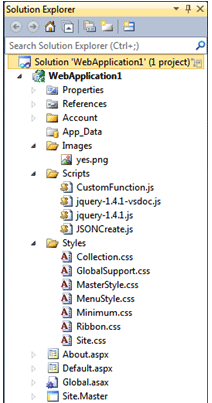
Scripts folder contains all the JavaScript files where as Styles contains all the CSS file. CSS and JS files takes milliseconds of time to load into the browser though it’s really matter how much time it’s takes to load the CSS and JS files.

This is how you refer the JavaScript and CSS in applications markup
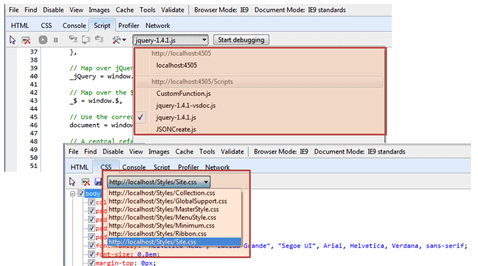
Run your application and inspect the loaded Css and JavaScript files using IE Developer toolbar . You can see all the mentioned css and JavaScript in the html markup loaded individually

To take a more granular look on the loading perspective, you can use the IE Developer toolbar. You will find there are individual request to download the css and javascript files and each of them taken individual time
You can take a quick look using YSlow statistics viewer for total number of request for javascript and css files
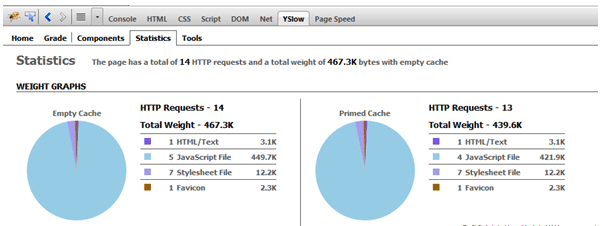
ASP.NET 4.5 Introduced Bundling and Minifying the files which reduce the number of requests by merging the files into a single one. Bundling combines multiple JavaScript files for faster loading and reduced the number of request to download the files and minification reduces the size of JavaScript and CSS files by removing unneeded characters.
To apply the binding and Minifying first of all you need to refer the folder for css and javascript instead of individual files. Along with the folder name you have the append css for CSS folder and js for JavaScript folder.

That’s all. Run the application once again and inspect the save thing for CSS and JavaScript in IE Developer Toolbar. Interestingly you will find only one CSS File and one JavaScript has been loaded

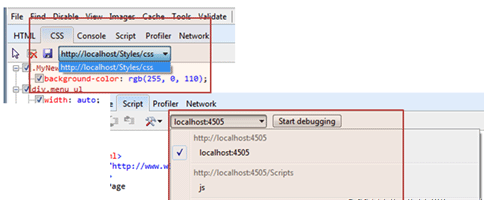
You can also use IE Developer toolbar to checkout the result. Yes, there is only two request, one for CSS and another for JavaScript. You can also find the significant amount of changes in file size and number of request for JS and CSS file also reduced

.NET 4.5 introduced a new class called BundleTable provides programmatic access to the collection of registered Bundle objects in an ASP.NET application. Bundle object contains the list of JavaScript or CSS files . ASP.NET runtime dynamically combines into a single virtual file that a browser can retrieve by using a single request
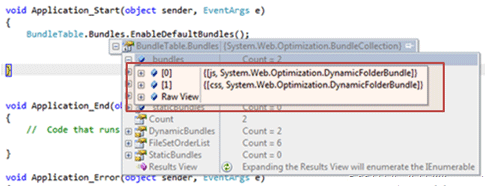
Every elements of Bundle object is a key value pair . Key is a string that define either “JS” or “Css” and Values contains the the type of System.Web.Optimization.DynamicFolderBundle

You can create your custom bundles for JavaScript as well as CSS. Below code snippets shows the same

Once you have your own bundle object, you can specify the same in your html markup as shown in below

Now, run the application and inspect your own created bundle in IE Developer toolbar

One of the biggest advantages of this custom bundle objects is, you can refer multiple directories as shown in below code snippet

As shown in above code snippet, we are adding one directory for bundling with filtering criteria of “.JS” file. Boolean values indicate while adding the directory, it will ignore the sub directories
.NET 2.0 has included System.Net.Mail code namespace for supporting email programming with .NET
Following is the code snippets for how to send mail from .NET application


There are many reasons why individuals or companies want to change to a new web hosting company. It could be as simple as not enough storage space or bandwidth, or it could be due to its customer service, or lack thereof.
Easier said than done? Changing to a new web hosting company may sound like a daunting task, but it doesn't have to be that complex - there are just a few things to keep in mind.
1. Keep your web hosting account with your existing host open
It is recommend that you keep your existing web hosting account active until you have completed the transition steps (ie. new account setup, file transfer, email creation and setup, DNS modification and propagation).This will ensure that your website and domain email accounts will be running during the transition.
2. Choose a suitable new web hosting provider
Considerations include:
a) Type of OS (Windows vs. Linux) - it depends on the technologies your website requires. For example, if your website requires ASP, MSSQL, MSACCESS or other Microsoft-specific technologies, then you will need to find a Windows-platform web hosting plan.
b) Bandwidth and disk space requirements
3. Make a backup copy of your existing website: download old account files
Ideally, files should be downloaded in the same tree structure in which you want to upload it later. Also look for any file or chmod permissions that you might to set on any folder or file. This is a fairly easy task and can easily be accomplished by FTP.
However, some free web hosting providers do not offer FTP access. This is especially true if you're currently using a free Flash/drag-and-drop website creation service (ie. Weebly.com, WIX.com).
If this is the case, you will not be able to download your existing web files and will have to re-create your new web files. You should check to see if your new web hosting provider offers a free website creator.
To avoid running into the same problem in the future, make sure your new web hosting provider offers FTP access.
4. Setup new (same) email addresses
To ensure that emails are properly received, it is important to keep the same email addresses, including email aliases and forwarders.
5. DNS changes and propagation
Once you have uploaded your web files to the new web hosting server and re-created your email accounts, you can go ahead and make the necessary domain name server (DNS) changes.
DNS is usually obtained once you have signed up with the new web hosting provider. You will need to replace your existing DNS settings with the new one - this is usually done via your domain management panel (your domain registrar).
The new DNS will take anywhere between 24-48 hours to propagate, therefore the old web host is responsible for website and email in the meantime. This is why cancelling the old service should be the very last thing to do.
6. Cancel your old account.
Once your new account has been activated and your website and email services at your new web hosting provider are up and running, you can proceed to have your old account cancelled.
If you need assistance in migrating your website to a new host, you can contact ASPHostCentral.com. We offer migration assistance FREE of CHARGE
I recently upgraded from Visual Web Developer 2008 to Visual Web Developer 2010 and have run into an issue, I started seeing a configuration error. In two cases I had been working on web applications in Visual Web developer 2010.
Case 1 appeared after I had opened an existing application and when prompted, do I want to configure the site for use with ASP.NET 4.0, I must have said yes.
Case 2 came when I created a new application and my system is setup to use Framework ASP.NET 4.0
In both situations I got the following error <compilation debug="true" targetFramework="4.0" /> pointing to my web.config file. I like working in Visual Web Developer 2010, but my hosting server is not yet setup for .Net Framework 4.0, so I needed to find out how to down-grade from 4.0 to 3.5 framework.
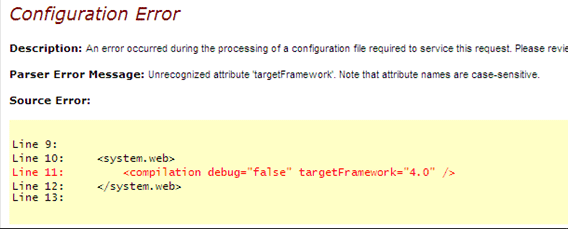
The following is what I did to change the target Framework from ASP.NET 4.0 to ASP.NET 3.5.
1) Ensure IIS and the ASP.NET properties are configured for Framework 2.0. Note: Framework 3.5 will not show up in the list of installed options due to the fact that framework 3.5 is an extension of 2.0 and not a stand alone release
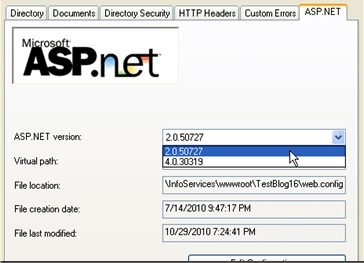
2) Configure you web application to use target Framework 4.0 by right clicking your website in the solution explorer >> Property Pages >> Build >> Change "Target Framework" to .NET Framework 3.5.
T

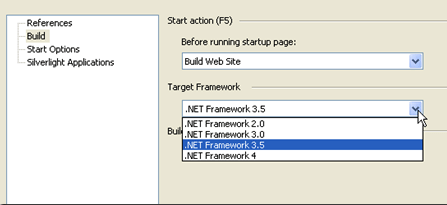
[This documentation is for preview only, and is subject to change in later releases. Blank topics are included as placeholders.]
This topic contains information about key features and improvements in the .NET Framework 4.5 Developer Preview. This topic does not provide comprehensive information and is subject to change.
New features and improvements are described in the following sections:
- .NET for Metro style apps
- Core New Features and Improvements
- Web
- Networking
- Windows Presentation Foundation (WPF)
- Windows Communication Foundation (WCF)
- Windows Workflow Foundation (WF)
.NET for Metro style apps
Metro style apps are designed for specific form factors and leverage the power of the Windows operating system. A subset of the .NET Framework is available for building Metro style apps for Windows using C# or Visual Basic. This subset is called .NET APIs for Metro style apps.
Core New Features and Improvements
The following features and improvements were added to the common language runtime and to .NET Framework classes:
- Ability to limit how long the regular expression engine will attempt to resolve a regular expression before it times out.
- Ability to define the culture for an application domain.
- Console support for Unicode (UTF-16) encoding.
- Support for versioning of cultural string ordering and comparison data.
- Better performance when retrieving resources.
- Zip compression improvements to reduce the size of a compressed file.
- Ability to customize a reflection context to override default reflection behavior through the CustomReflectionContext class.
Managed Extensibility Framework (MEF)
The Managed Extensibility Framework (MEF) provides the following new features:
- Support for generic types.
- Convention-based programming model that enables you to create parts based on naming conventions rather than attributes.
- Multiple scopes.
Asynchronous File Operations
In the .NET Framework 4.5 Developer Preview, new asynchronous features were added to the C# and Visual Basic languages. These features add a task-based model for performing asynchronous operations. To use this new model, use the asynchronous methods in the I/O classes.
Web
ASP.NET 4.5 Developer Preview includes the following new features:
- Support for new HTML5 form types.
- Support for model binders in Web Forms. These let you bind data controls directly to data-access methods, and automatically convert user input to and from .NET Framework data types.
- Support for unobtrusive JavaScript in client-side validation scripts.
- Improved handling of client script through bundling and minification for improved page performance.
- Integrated encoding routines from the AntiXSS library (previously an external library) to protect from cross-site scripting attacks.
- Support for WebSockets protocol.
- Support for reading and writing HTTP requests and responses asynchronously.
- Support for asynchronous modules and handlers.
- Support for content distribution network (CDN) fallback in the ScriptManager control.
Networking
The .NET Framework 4.5 Developer Preview provides a new programming interface for HTTP applications. For more information, see the new System.Net.Http and System.Net.Http.Headers namespaces.
Also, the following networking improvements are included in the System.Net, System.Net.Mail, and related namespaces:
- Improved internationalization and IPv6 support.
- RFC-compliant URI support.
- Support for Internationalized Domain Name (IDN) parsing.
- Support for Email Address Internationalization (EAI).
Windows Presentation Foundation (WPF)
In the .NET Framework 4.5 Developer Preview, Windows Presentation Foundation (WPF) contains changes and improvements in the following areas:
- The new Ribbon control, which enables you to implement a ribbon user interface that hosts a Quick Access Toolbar, Application Menu, and tabs.
- The new INotifyDataErrorInfo interface, which supports synchronous and asynchronous data validation.
- New features for the VirtualizingPanel and Dispatcher classes.
- Improved performance when displaying large sets of grouped data, and by accessing collections on non-UI threads.
- Data binding to static properties, data binding to custom types that implement the ICustomTypeProvider interface, and retrieval of data binding information from a binding expression.
- Repositioning of data as the values change (live shaping).
- Better integration between WPF and Win32 user interface components.
- Ability to check whether the data context for an item container is disconnected.
- Ability to set the amount of time that should elapse between property changes and data source updates.
- Improved support for implementing weak event patterns. Also, events can now accept markup extensions.
Windows Communication Foundation (WCF)
In the .NET Framework 4.5 Developer Preview, the following features have been added to make it simpler to write and maintain Windows Communication Foundation (WCF) applications:
- Simplification of generated configuration files.
- Support for contract-first development.
- Ability to configure ASP.NET compatibility mode more easily.
- Changes in default transport property values to reduce the likelihood that you will have to set them.
- Updates to the XmlDictionaryReaderQuotas class to reduce the likelihood that you will have to manually configure quotas for XML dictionary readers.
- Validation of WCF configuration files by Visual Studio as part of the build process, so you can detect configuration errors before you run your application.
- New asynchronous streaming support.
- New HTTPS protocol mapping to make it easier to expose an endpoint over HTTPS with Internet Information Services (IIS).
- Ability to generate metadata in a single WSDL document by appending ?singleWSDL to the service URL.
- Websockets support to enable true bidirectional communication over ports 80 and 443 with performance characteristics similar to the TCP transport.
- Support for configuring services in code.
- XML Editor tooltips.
- ChannelFactory caching support.
- Binary encoder compression support.
Windows Workflow Foundation (WF)
Several new features have been added to Windows Workflow Foundation (WF) in the .NET Framework 4.5 Developer Preview. These new features include:
- Ability to create state machine workflows.
- Enhanced Workflow Designer features such as the following:
- Enhanced workflow search capabilities in Visual Studio, including Quick Find and Find in Files.
- Ability to automatically create a Sequence activity when a second child activity is added to a container activity, and to include both activities in the Sequence activity.
- Panning support, which enables the visible portion of a workflow to be changed without using the scroll bars.
- A new Document Outline view that shows the components of a workflow in a tree-style outline view and lets you select a component in the Document Outline view.
- Ability to add annotations to activities.
- Ability to define and consume activity delegates by using the workflow designer.
- Auto-connect and auto-insert for activities and transitions in state machine and flowchart workflows.
- Storage of the view state information for a workflow in a single element in the XAML file, so you can easily locate and edit the view state information.
- A NoPersistScope container activity to prevent child activities from persisting.
- Support for C# expressions:
- Workflow projects that use Visual Basic will use Visual Basic expressions, and C# workflow projects will use C# expressions.
- C# workflow projects that were created in Visual Studio 2010 and that have Visual Basic expressions are compatible with C# workflow projects that use C# expressions.
- Versioning enhancements:
- The new WorkflowIdentity class, which provides a mapping between a persisted workflow instance and its workflow definition.
- Side-by-side execution of multiple workflow versions in the same host, including WorkflowServiceHost.
- In Dynamic Update, the ability to modify the definition of a persisted workflow instance.
- Contract-first workflow service development, which provides support for automatically generating activities to match an existing service contract
This article is sourced from http://msdn.microsoft.com/en-us/library/ms171868(v=VS.110).aspx as it is correct as per 19th Sept 2011.